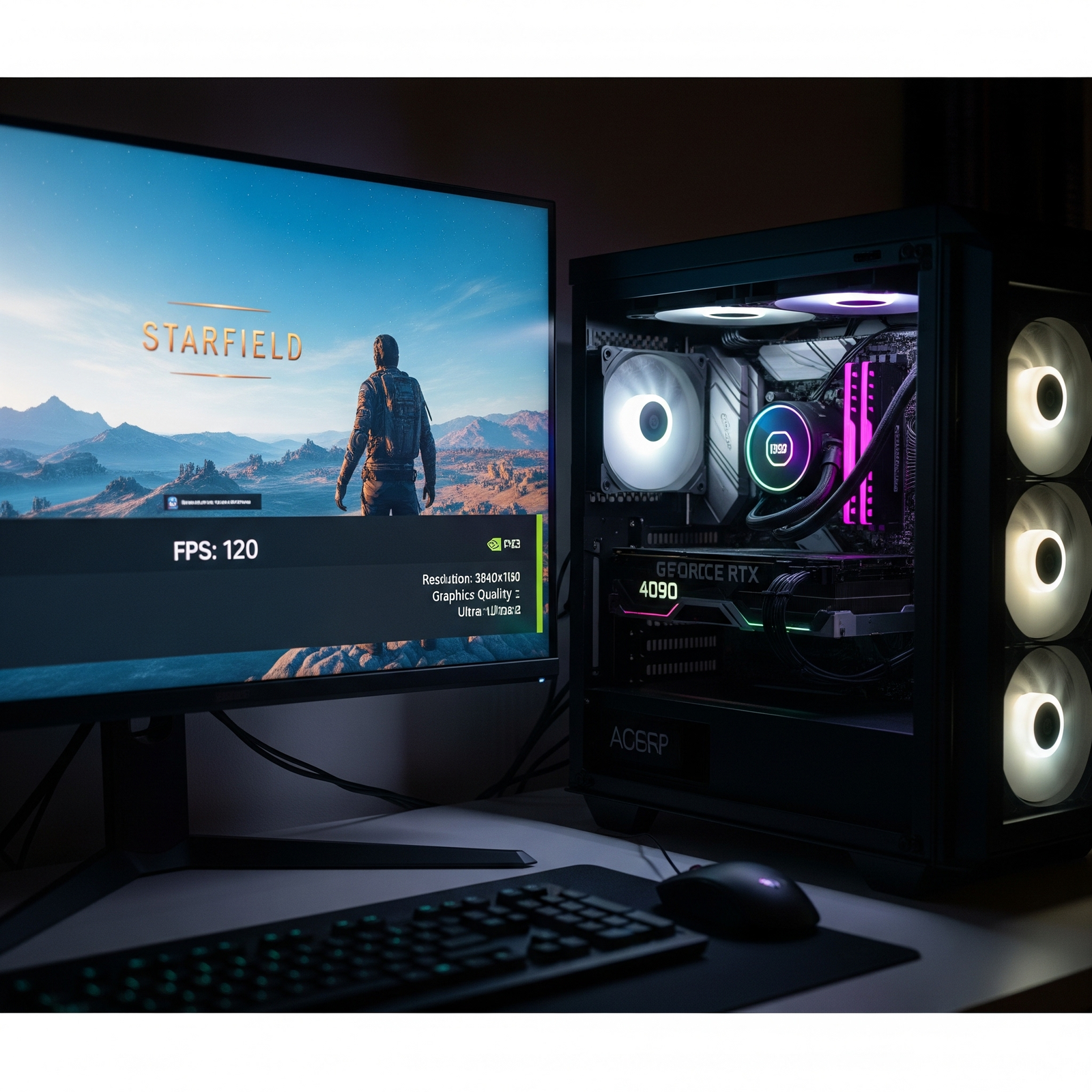When Starfield launched in September 2023, its PC performance was a significant point of contention. While visually ambitious, the game suffered from demanding CPU requirements, inconsistent frame rates, and a lack of modern upscaling technologies at launch (like DLSS). Nearly two years later, with multiple major patches, driver updates, and the official release of the Creation Kit allowing for robust modding, the burning question remains: has Starfield’s PC performance been fixed?
The answer, as of August 2025, is a resounding “significantly improved, but still demanding.” Bethesda has put in considerable work to optimize the game, and the landscape for PC players is far better than at launch.
The Journey from Launch to Now:
Starfield’s initial PC performance was characterized by:
- High CPU Usage: Even powerful CPUs struggled in dense city areas like New Atlantis.
- Lack of Upscalers: Only AMD’s FSR 2 was supported at launch, with no native DLSS or XeSS, a major drawback for NVIDIA and Intel GPU users.
- Stuttering and Frame Drops: Particularly noticeable in transitions, busy areas, and during combat.
- No Official Ultrawide Support: Required community mods.
Fast forward to 2025, and Bethesda has addressed many of these issues through a series of patches. Key improvements include:
- Native DLSS 3 and FSR 3 Support: This was a game-changer, especially for NVIDIA RTX 40-series users who can leverage Frame Generation for significant FPS boosts, and for all users benefitting from better upscaling quality.
- General Performance Optimizations: Patches have improved CPU utilization and memory management, leading to smoother overall gameplay and reduced stuttering.
- Official Ultrawide Monitor Support: A welcome addition for panoramic space exploration.
- Driver Optimizations: Both NVIDIA and AMD have released numerous driver updates specifically tailored for Starfield, enhancing performance and stability.
- Creation Kit Release: While not a direct performance fix, the official modding tools (released in early 2025) have enabled the community to develop further optimization mods, including texture packs, UI improvements, and more.
Current PC Performance Landscape:
For players with modern, mid-to-high-end PCs, Starfield now generally runs much smoother. Achieving a stable 60+ FPS at 1080p or even 1440p on high settings is much more feasible, especially when utilizing upscaling technologies. 4K remains demanding but is achievable with top-tier hardware and upscaling.
However, it’s still a Bethesda game on the Creation Engine, meaning some fundamental characteristics persist:
- CPU Bottlenecks in Dense Areas: While improved, major cities like New Atlantis can still be CPU-intensive, leading to dips even on powerful systems.
- Loading Screens: These are still frequent due to the game’s design, though SSDs make them very quick.
- Occasional Hitches/Stutters: While greatly reduced, minor stutters can still occur, particularly after prolonged play sessions or in heavily scripted sequences. Some users still report micro-stuttering issues in specific scenarios.
- Storage Requirement: An SSD is still mandatory for a playable experience; running it on an HDD will result in unplayable performance and endless loading.
Recommended PC Specifications (as of 2025):
While the official minimum and recommended specs haven’t drastically changed, the experience they deliver has. For a good experience at 1080p/60fps (with upscaling):
- OS: Windows 10/11 (64-bit)
- Processor: AMD Ryzen 5 3600X / Intel Core i5-10600K or newer
- Memory: 16 GB RAM
- Graphics: AMD Radeon RX 6800 XT / NVIDIA GeForce RTX 2080 or better (RTX 30-series or 40-series, RX 7000-series highly recommended for higher resolutions and framerates)
- DirectX: Version 12
- Storage: 125 GB SSD (NVMe preferred)
For 1440p or 4K at higher framerates, an RTX 3080/RX 6800 XT equivalent or higher is highly recommended, paired with a modern CPU (Ryzen 5000/7000 series, Intel 12th/13th/14th Gen) and making full use of DLSS/FSR with Frame Generation.
Optimization Tips for PC Players:
- Always Update Drivers: Ensure your NVIDIA, AMD, or Intel GPU drivers are the latest versions. These often include game-specific optimizations.
- Use Upscaling (DLSS/FSR): Even if you have a powerful GPU, enabling DLSS (for NVIDIA) or FSR (for AMD/Intel/others) with Quality or Balanced settings can provide significant performance headroom without a major visual hit. If your GPU supports Frame Generation (RTX 40-series, RX 7000-series, or FSR 3 compatible), enable it for substantial FPS increases.
- Install on an SSD: This is non-negotiable. An NVMe SSD is ideal.
- Tweak In-Game Settings:
- Shadow Quality: This is often a major performance hog. Lowering shadows from Ultra to High or Medium can provide significant FPS gains.
- Volumetric Lighting: Another demanding setting; try lowering it for better performance.
- Crowd Density: Can impact CPU performance in cities; consider lowering if experiencing stutters in populated areas.
- Motion Blur & Film Grain: These are subjective and can be turned off for a cleaner image and slight performance boost.
- Utilize Community Mods: The official Creation Kit has opened doors for amazing performance-enhancing mods. Look for:
- INI Tweaks: Mods that optimize game configuration files.
- Texture Replacers: Lower resolution textures for VRAM-limited GPUs.
- Performance Fixes: Specific mods addressing various bottlenecks or stutters.
- Windows Optimization: Ensure Game Mode is on, Hardware-accelerated GPU Scheduling is enabled (if available), and your power profile is set to “High Performance.”
Conclusion:
Starfield’s PC performance in 2025 is a testament to persistent post-launch support. While not perfect and still demanding on hardware, especially in CPU-heavy scenarios, it’s a vastly more polished and enjoyable experience than at its initial release. With proper hardware and judicious use of optimization settings and upscaling technologies, exploring the vast cosmos of Starfield can now be a smooth and visually stunning journey for PC gamers. If you held off due to performance concerns, now is a much better time to jump in.










